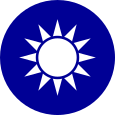This is an old revision of this page, as edited by JohnLo1223 (talk | contribs) at 04:25, 5 June 2007. The present address (URL) is a permanent link to this revision, which may differ significantly from the current revision.
Revision as of 04:25, 5 June 2007 by JohnLo1223 (talk | contribs)(diff) ← Previous revision | Latest revision (diff) | Newer revision → (diff)Template:Infobox ROC Political Party
The New Party (新黨, xīndăng), formerly the Chinese New Party (CNP; 中華新黨, zhōnghúa xīndăng), is a political party in the Republic of China.
The Chinese New Party was formed out of a split from the then-ruling Kuomintang (KMT) by members of the New Kuomintang Alliance in August 1993. Members of the Alliance had accused KMT Chairman Lee Teng-hui of autocratic tendencies and moving the party away from Chinese reunification. Originally, the party wanted to keep the name of the faction, but was prevented from doing so due to the similarity of names. The name "New Party" was seemingly inspired by the contemporary electoral success of the Japanese political party Shin-to Sakigake ("New Party Renegades"; see Politics of Japan).
In the mid-1990s, the New Party attracted support from the KMT old guard as well as young urban professionals. The New Party was aided by former Finance Minister Wang Chien-shien and former Environmental Protection Administration Director Jaw Shaw-kong, who had charismatic and clean images.
In the 2000 Presidential Election, the party nominated writer and dissident Li Ao who ran a spirited but token campaign. In the election, most members of the party supported James Soong, and in fact both Li Ao and the convenor of the New Party encouraged people to do so.
In the 2006 Elections, the New Party made significant gains, seating over a dozen members into public office. The New Party also gained four seats in Taipei Major private offices.
As the New Party grew out of the Kuomintang, it is usually associated with the pan-blue coalition. Its party color is yellow.
See also
- History of the Republic of China
- Politics of the Republic of China
- Elections in the Republic of China
- List of political parties in the Republic of China
- Political divisions of the Republic of China
- Political status of Taiwan

